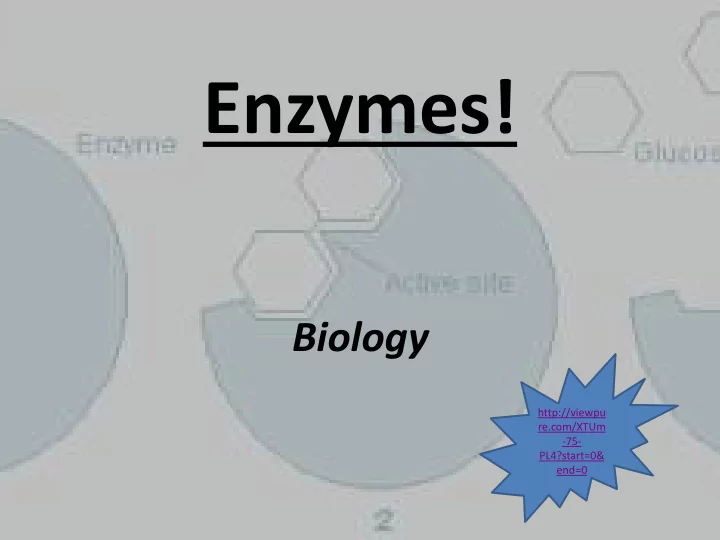

Enzymes! Biology http://viewpu re.com/XTUm -75- PL4?start=0& end=0
What does an enzyme do? Lowers activation energy so that the product can form faster.
Step 1 – Step 3 – Products Substrate binds are released and Step 2 – Enzyme to active site of enzyme can be changes shape enzyme used again causing substrate to break apart (or bond)
Enzyme names often end in – ase • Sucrase – breaks down sucrose (sugar) • Lipase – breaks down lipids • Catalase – breaks down hydrogen peroxide (H 2 O 2 ) in cells • Starch synthase – makes starch in plants http://viewpur e.com/3Tn- 7JcZJuQ?start= 0&end=0
Factors that Affect Enzymes • Temperature – Too hot: denatures protein structure, enzyme falls apart – Too cold: lowers kinetic energy, enzyme slows down – Optimal temp in humans: 37 º C
Factors that Affect Enzymes https://vi meo.com/ 86362472 2. pH – Too acidic or too basic can denature the protein structure, changes shape of active site – Enzymes have an optimal pH depending on where they function
https://www.google.com/url?sa=i&rct=j&q=&esrc=s&source=images&cd=&cad=rja&uact=8&ved=0ahUKEwjv66SYoJ7LAhX MGR4KHez1CdMQjB0IBg&url=http%3A%2F%2Fwww.rsc.org%2Flearn-chemistry%2Fresources%2Fchemistry-in-your- cupboard%2Fvanish%2F8&psig=AFQjCNFN6wFjYVL_Vc6UFl-cb2Bf7Iu5Ag&ust=1456875515003082
Factors that Affect Enzymes 3. Concentration of Enzyme or Substrate • If enzyme concentration is low, the reaction is slow. • As the enzyme concentration increases, the rate of reaction increases. http://www.rsc.org/Education/Teachers/Resources/cfb/enzymes.htm
http://viewp ure.com/Nd MVRL4oaUo ?start=0&en d=0 • As the substrate increases, the reaction increases, up to a certain point (enzyme is limited). http://faculty.clintoncc.suny.edu/faculty/micha el.gregory/files/bio%20101/bio%20101%20lab oratory/enzymes/enzymes.htm
Activity / Homework • Complete the Enzyme- Substrate Manipulation Activity
Enzyme Substrate Complex
ATP & Energy Our main energy currency
• ATP= Adenosine Triphosphate • Macromolecule: Nucleic Acid • Organelle: Made in the Mitochondria • Main Function: Main energy currency in all living things. • Comes from: breakdown of glucose (carbohydrates).
Structure: Made up of adenine, ribose, and three phosphates
Differences ATP ADP • 3 phosphates • 2 phosphates • High energy • Low energy
phosphate removed
• Fats store the most energy. – 80 % of the energy in your body. – 1 triglyceride ≈ 148 ATP • Carbohydrates – Not stored in large amounts. – 1 glucose ≈ 36 ATP • Proteins – Not likely to be used for energy
Review Questions 1. The substrate is also known as the _________________ in a chemical reaction. 2. List three ways in which enzymes can be altered. 3. Some organisms live in very hot or very acidic environments. Would their enzymes function in a person’s cells? Why or why not? 4. Suppose that the amino acids that make up an enzyme’s active site are changed, how might this change affect the enzyme? 5. What is the main function of ATP? 6. How do we obtain ATP? 7. Which organic molecule is used by the body as a good source of long term energy storage? 8. Proteins are composed of chains of ______________________
Label the Diagram
Recommend
More recommend